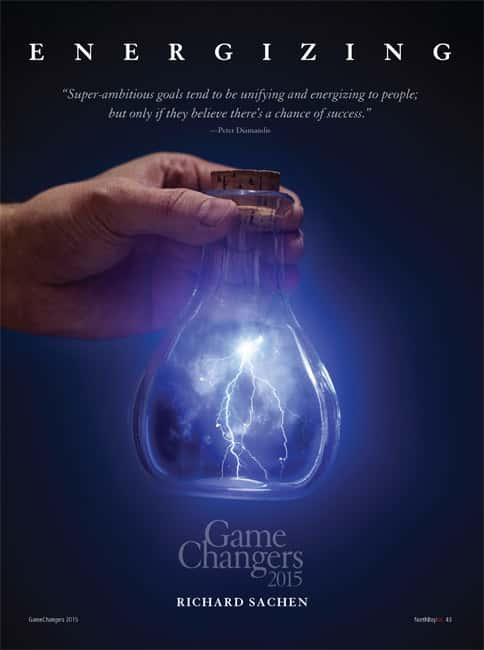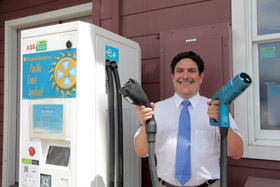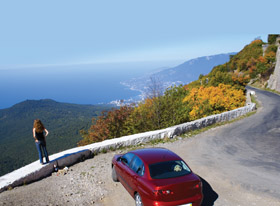“Super-ambitious goals tend to be unifying and energizing to people, but only if they believe there’s a chance of success.” —Peter Diamandis
 Imagine a clear, smog-free sky, freedom from spare-the-air days and fueling your car while you have lunch. That’s the future Richard Sachen envisions, and he’s counting on it with Sunspeed Enterprises, a Point Reyes Station startup that’s installing electric vehicle chargers along the Pacific Coast Highway from Eureka to Malibu, placing the hubs outside restaurants and hotels so drivers can relax and enjoy themselves while they’re charging their cars.
Imagine a clear, smog-free sky, freedom from spare-the-air days and fueling your car while you have lunch. That’s the future Richard Sachen envisions, and he’s counting on it with Sunspeed Enterprises, a Point Reyes Station startup that’s installing electric vehicle chargers along the Pacific Coast Highway from Eureka to Malibu, placing the hubs outside restaurants and hotels so drivers can relax and enjoy themselves while they’re charging their cars.“One of the reasons I went for the Pacific Coast Highway is, it’s a beautiful place. If we can put electric vehicles on it, it’s going to be even better,” says Sachen, 51, who wants to give drivers of electric cars the opportunity to make the most of California’s coast without experiencing the “range anxiety” that comes with looking for charging stations.
At first, West Marin seems like an unlikely location for a technology-related startup, but given Sachen’s background and business savvy, it’s not surprising. A California native, he was born in San Francisco and grew up in west San Jose amid orchards with a clear view of the mountains. He and his wife, Eva, moved to Petaluma with their two young children 10 years ago. He launched Sunspeed Enterprises in 2012, working out of the SoCo Nexus/iHub in Rohnert Park. In 2013, he began looking for an independent office, and he wanted a rural location so the business could quality for loans and grants from the Department of Agriculture’s rural electrification program.
 When he found the office in Point Reyes Station, he discovered it was formerly a print shop and already had upgraded power, so he didn’t have to pay as much for further upgrades to install the chargers. In addition, the building used to be a livery stable, then a trucking company, and, “Now we have electric vehicles,” he says. “I thought it was continuing the legacy of transportation.”
When he found the office in Point Reyes Station, he discovered it was formerly a print shop and already had upgraded power, so he didn’t have to pay as much for further upgrades to install the chargers. In addition, the building used to be a livery stable, then a trucking company, and, “Now we have electric vehicles,” he says. “I thought it was continuing the legacy of transportation.”The charger opened in January 2014, and the choice of location is a melding of pragmatic business practices and the entrepreneur’s willingness to try something new. But the concept of powering vehicles with electricity has a philosophical bent as well. Sachen is sold on the benefits of electric vehicles. When the Nissan Leaf came out, he began looking at grants and saw the opportunity to get a new car without any money out of pocket. “The lease payment is pretty reasonable, particularly when you consider I’m not paying $200 for gas anymore,” he says, adding, “I have solar on my roof, so it costs nothing to fuel the car.”
Performance and low maintenance are also part of the appeal. “They’re zippy; they cost nothing to maintain,” he says, pointing out they’re clean and quiet, and the parts that can go wrong in a gas-powered vehicle don’t exist in electric cars. The only downside is a limited number of charging stations. But with more than 100,000 electric vehicles on the road in the United States, that’s bound to change, and he’ll be part of the revolution with the Pacific SunTrail Route.
Journey of an entrepreneur
Sachen’s road to entrepreneurship has had its twists and turns, but it’s been more of an evolution than an obstacle course, with opportunities for learning all along the way. His first job was painting models for a game shop when he was in high school, and he’s always enjoyed building things and figuring out how they work. He studied architecture and construction at the California Polytechnic State University in San Luis Obispo, where he earned a degree in construction management, and followed that with an MBA from Santa Clara University. After graduation from college, he worked as a scheduler for United Technologies, an American multinational conglomerate that built rocket boosters until the Cold War ended. He also spent time as a planner/scheduler for Varian’s medical equipment group.
By 2002, he was working for KLA-Tencor, putting in long hours in the high-tech industry, and felt the need for a change. “We had two small children and I wanted to do something different,” he says. So he designed and built a dual-monitor computer stand, began the patent application process and launched his first startup, Lady Bug Electronics. He sold about 100 of the monitor stands, including some to San Jose State University’s library, but couldn’t get the costs down enough to do it profitably. So in 2004, he closed the business.
He moved on, but he’d learned some valuable lessons. He describes Lady Bug Electronics as a lifestyle company under sole proprietorship and says, “It was a difficult market to get into. Market research isn’t as easy to do as I thought it was.”
“One of the most interesting things for me was that I thought I had to have permission for more things,” he adds, explaining that he got to see business practices from a different perspective, and it wasn’t as difficult as he’d expected. The time at Lady Bug also gave him the opportunity to add to his credentials. “I got an ergonomic certificate while I was there,” he says.
Next, he went to Xandex, Inc., a producer of semiconductor products in Petaluma, where he was the materials manager, shipping, receiving and scheduling inventory. His job was to help the company grow into a new product line, which was interface equipment that it sold to companies such as Agilent Technologies. That line ended, however, and Xandex started to get involved in renewable energy. Sachen was laid off in 2012 as a result of a gap between the old project and a new one, but came away equipped with new knowledge and skills.
“In a number of companies, I’ve helped with new product introduction and with computers and databases. If I can’t find the system on the market, I’m quite savvy at database design now,” he says. “I’ve learned a lot about systems and systems development and designing something that’s repeatable,” he adds, explaining that he developed a serial number database to track a product from the supplier to the production line in the field where it’s being scaled. It is, for example, possible to scan a number from a rooftop where a solar installation is taking place.
The layoff from Xandex gave Sachen the chance to pursue new opportunities. He applied to and completed the 2012 California Program for Entrepreneurship at the University of Santa Clara, which offered fellowships to alumni, and he saw the documentary film “Who Killed the Electric Car?,” which spurred him to work on ideas for electric vehicle businesses and apply for the certificate in entrepreneurship. He came up with an idea for wireless power transfer, which he describes as kind of like a slot car but without a connection, and decided to start Sunspeed Enterprises as a way to charge electric vehicles on the move.
In March 2013, Sonoma County sent out a questionnaire asking electric vehicle owners where they wanted chargers. Many said they wanted to get to the rural areas and to the beach and back. The county, however, decided to focus on the Highway 101 corridor, so Sachen saw an opportunity and did some research. “All my competition was ignoring the coast,” he says. He decided to create the Pacific SunTrail Route and put chargers along the Pacific Coast Highway. “We’re going to locations that are a little bit off the beaten path,” he explains.
Each station will have two outlets, one with CHAdeMO, a quick-charging method for electric batteries that was developed in Japan; and a combination charging system that originated in the United States and Europe. Sachen explains that Sunspeed Enterprises is putting more than one charging system in each location, so a hub isn’t just for one model, such as Testla, Leaf or BMW. “Anything that plugs in, we’ll have an outlet for,” he says. When the trail is complete, it’ll have 30 to 40 charging stations. The EV hub at Point Reyes Station is already up and running, and Sachen has approval for one at the Madonna Inn in San Luis Obispo.
He’s also working on charging stations in Duncans Mills and Valley Ford but needs investment funds to complete them. His goal is to spend 2015 and 2016 building the hubs and then focus on operations. “After we finish building the Pacific SunTrail, we’ll start looking at other opportunities,” he adds, giving an Alaskan trail, the Appalachian Trail and one in Maine as possibilities for the future.
 Raising capital
Raising capital
Sunspeed Enterprises will install hubs as funding becomes available, so the challenge now is financing. Sachen started with grants, some personal money and angel investment, but as he became familiar with the angel investment circuit, he found that most investors are interested in projects that are more technological. “I’m not actually building any of this equipment,” he says, and explains that he’s purchasing it from reliable companies, so it isn’t patentable. “It’s really just a business model that’s a little unique.”
That meant finding another strategy, and he turned to crowdfunding, using websites such as Kickstarter and IndieGoGo to raise some funds and giving Sunspeed-related memorabilia, gift certificates from businesses in Point Reyes Station and free charging for a period of time in return for contributions.
Then he heard Jenny Kassan of Cutting Edge Capital speak at a green business conference and became interested in stock offerings, which led the company to issue a private placement memorandum offering $3 million in common stock to residents of California. “It makes sense to open up the funding and ownership to Californians,” says Sachen. “We’re building a following. We’re doing another push this quarter to increase our exposure.”
Looking to the future
Raising capital is a necessary part of business development. But, says Sachen, “I like to build things, that’s why I’ve always been in manufacturing firms. Building and doing the operations part is my bliss and joy.” Eventually, he hopes to get back to wireless road technology. “You get power from the road,” he explains and says that, although inductive charging road technology has been around for a while, researchers at MIT and in Japan have now found a way to create harmonic resonance so it’s possible to conduct electricity by tuning into a specific frequency without impacting human beings. “That’s the big dream,” he says.
“You get power from the road and have a small battery to get your car from home and back. I think it would be really cool to try that in Santa Rosa or Petaluma, where you have a well-traveled area.” He notes it’s completely green and would solve problems such as limited range and recharge time—and it could use a fast pass system for payment.
That kind of vision is one of the characteristics that makes Sachen an entrepreneur, along with his patience and determination. He also believes that a flexibility of mind is important for success. “Not everything I thought would be has turned out to be. You have to adjust your plans accordingly. But it’s been an interesting journey,” he says.
“The most enjoyable part has been finding sites and talking to the site owners,” says Sachen, who finds they get excited about electric vehicles and the possibilities he’s offering. “That kind of makes my day. I get to drive out on the Pacific Coast. It’s the most beautiful coast in the world, in my opinion.” He looks forward to the day when all the hubs are in place and says, “We’re building the Pacific Coast SunTrail. You’re not going to notice that you spent time charging. You’re going to notice that you’ve had a good time discovering California.”
It’s a vision for the future, and it’s almost here.
Electric Vehicles
“I’m really bullish on electric vehicles,” says Richard Sachen, who considers conventional vehicles with their toxic gases a necessary evil. “Now we have the opportunity to get rid of [internal combustion],” he says. “Once they figure out how to bring the cost of a Tesla vehicle down to around $30,000, there’s no reason to stick with a gas car, anymore than there’s a reason to have gas lamps in your home.”
Getting a Charge
“When I got the Nissan Leaf, we took advantage of a program and got a free charger installed. That was kind of a cool deal at the time,” says Richard Sachen. It was a Blink level two EV charger for home use, and the program compiled information on how people used electric vehicles. “Now you can get a charger from Home Depot for less than $500,” he says.
Three types of charges are available:
Level one is 110 volts. “That’s very slow, but you can plug it into any car,” says Sachen, describing it as useful in emergencies.
Level two is 220 volts and is like a clothes dryer circuit. It charges a car in about three hours and is good for the workplace.
Level three is a DC charger and will charge a Leaf in 30 minutes. It’s more expensive, but more convenient.” You can stop off and get a cup of coffee and, when you come back, your car is charged,” says Sachen. “That’s the charger I’m putting along the Pacific Coast Highway. When you’re traveling, the fast charge is really the way to go.”
“Who Killed the Electric Car?”
Richard Sachen cites the documentary feature film, “Who Killed the Electric Car?,” as one of his inspirations for founding Sunspeed Enterprises. Writer/director Chris Paine’s film tells the story of the development of battery-powered electric cars in the United States in the 1990s, focusing on General Motors’ EV1, which was popular with drivers but met its demise when GM recalled the cars and crushed them in the Arizona desert. Martin Sheen is the narrator, and fans of the car, including actor Tom Hanks, producer Chelsea Sexton and consumer activist Ralph Nader, make appearances. The film had its premiere at the Sundance Film Festival in 2006 and is now available on DVD from Sony Home Entertainment.
Great Idea
Alan Soule, president of the North Bay Chapter of the Electric Auto Association, believes the Pacific Coast SunTrail will be an invaluable resource for drivers of electric vehicles. “To date, the established EV charging station operators haven’t installed charging stations along Highway 1 on the California coast. Upon completion, the Pacific Coast SunTrail will enable EV drivers access to the coast, whether it’s Sea Ranch, Bodega Bay, Monterey or San Luis Obispo,” he says. “To enhance the convenience, each of the charging stations will have a DC Fast Charger, which will enable EV drivers to get a charge while having a cup of coffee or lunch. Convenient charging like this will make EVs more appealing to more and more people.”



